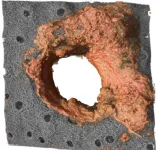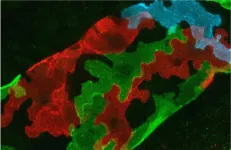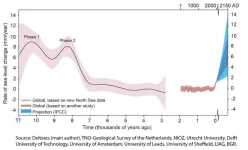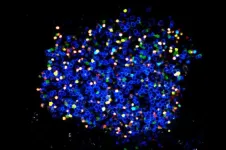(Press-News.org) NEW YORK, March 19, 2025 – Imagine a world where your phone stays cool no matter how long you use it, and it’s also equipped with tiny sensors that can identify dangerous chemicals or pollutants with unparalleled sensitivity and precision. Newly published research in the journal Nature demonstrates a new way of generating long-wave infrared and terahertz waves, which is an important step toward creating materials that can help realize these technological advances. The work, led by researchers at the Advanced Science Research Center at the CUNY Graduate Center (CUNY ASRC) paves the way for cheaper, smaller long-wave infrared light sources and more efficient device cooling.
Phonon-polaritons are a unique type of electromagnetic wave that occurs when light interacts with vibrations in a material’s crystal lattice structure. These phonon-polariton waves exhibit several unique characteristics. For example, they can concentrate the energy of long-wavelength infrared light into extremely small volumes, even down to tens of nanometers, as well as effectively move heat away from the source. This makes phonon-polaritons ideal for high-tech applications like sub-wavelength imaging, molecular sensors, and heat management within electronics. However, research on phonon-polariton waves has primarily focused on fundamental studies in laboratory settings, with practical device applications remaining largely unexplored.
“One major challenge is that exciting and detecting phonon-polariton waves is both expensive and inefficient, typically involving costly mid-infrared or terahertz lasers and near-field scanning probes,” said corresponding author Qiushi Guo, a professor with the CUNY ASRC’s Photonics Initiative and the CUNY Graduate Center’s Physics program.” We wanted to explore whether we could emit phonon-polaritons using just an electrical current, similar as how semiconductor lasers or LEDs work.” Guo said.
In this study, Guo's team (in collaboration with researchers from Yale University, California Institute of Technology, Kansas State University and ETH Zurich) found that the key was selecting the right combination of materials: a thin layer of graphene sandwiched between two hexagonal boron nitride (hBN) slabs.
First, in hBN, phonon-polaritons possess a significantly higher density of states and can propagate within the bulk, behaving like deep-subwavelength light rays that bounce back and forth between material boundaries. These specialized phonon-polaritons are referred to as hyperbolic phonon-polaritons (HPhPs).
Graphene is well known for its high electron mobility at room temperature. When encapsulated by hBN slabs, its mobility is further enhanced due to surface passivation and reduced impurities. “This means that when a current passes through the graphene encapsulated by hBN slabs, electrons in graphene can be accelerated to very high speeds and efficiently scatter with HPhPs in hBN.”, Guo explained.
The idea proved successful in the experiment. Remarkably, the team observed the emission of HPhPs when applying a modest electric field of just 1 V/µm to the graphene, highlighting the efficiency of HPhP electroluminescence. The study provides the first experimental demonstration of exciting phonon polariton waves exclusively through electrical methods.
The study also revealed intriguing physics underlying the HPhP electroluminescence. Specifically, the team identified two possible pathways for HPhP emission. “When the electron concentration in graphene is low, HPhPs are emitted through interband transitions. However, at higher electron concentrations, HPhP emission occurs through both interband transitions and intraband Cherenkov radiation in graphene”, said former Caltech postdoc Iliya Esin, now an assistant professor of physics at Bar Ilan University, Israel and a corresponding author of the study.
This discovery not only opens new avenues for developing nanoscale long-wave infrared or terahertz light sources but also presents exciting opportunities for energy applications. During the HPhPs electroluminescence, hot electrons in graphene rapidly lose their excess kinetic energy—the primary cause of overheating. Harnessing this mechanism can enable efficient heat dissipation in electronic devices, according to Guo.
The electrically pumped phonon-polariton light sources open the door to practical, scalable technologies. From next generation molecular sensing to improved heat management in electronics, this innovation lays the foundation for transformative advancements in energy-efficient, compact technologies that could redefine our modern devices.
About the Graduate Center of The City University of New York
The CUNY Graduate Center is a leader in public graduate education devoted to enhancing the public good through pioneering research, serious learning, and reasoned debate. The Graduate Center offers ambitious students nearly 50 doctoral and master’s programs of the highest caliber, taught by top faculty from throughout CUNY — the nation’s largest urban public university. Through its nearly 40 centers, institutes, initiatives, and the Advanced Science Research Center, the Graduate Center influences public policy and discourse and shapes innovation. The Graduate Center’s extensive public programs make it a home for culture and conversation.
About the Advanced Science Research Center at the CUNY Graduate Center
The Advanced Science Research Center at the CUNY Graduate Center (CUNY ASRC) is a world-leading center of scientific excellence that elevates STEM inquiry and education at CUNY and beyond. The CUNY ASRC’s research initiatives span five distinctive, but broadly interconnected disciplines: nanoscience, photonics, neuroscience, structural biology, and environmental sciences. The center promotes a collaborative, interdisciplinary research culture where renowned and emerging scientists advance their discoveries using state-of-the-art equipment and cutting-edge core facilities.
END
Good vibrations: Scientists discover a groundbreaking method for exciting phonon-polaritons
The breakthrough paves the way for novel nanoscale lasers and efficient electronic device cooling.
2025-03-19
ELSE PRESS RELEASES FROM THIS DATE:
CNIC scientists discover a type of immune cell that produces defensive "shields" in the skin
2025-03-19
A team at the Centro Nacional de Investigaciones Cardiovasculares (CNIC) led by Dr. Andrés Hidalgo has discovered a specialized population of neutrophils in the skin that produce extracellular matrix, helping to maintain the skin’s resistance and integrity. The study, published in Nature, demonstrates that the immune system not only targets pathogens, but also physically strengthens the skin to prevent them entering the body.
Neutrophils are an important type of circulating immune cell. The specialized neutrophils described ...
Science behind “Polly want a cracker” could guide future treatment design for speech disorders
2025-03-19
A new study explains how a parakeet’s brain helps it to mimic human words.
By recording for the first time the brain activity of parakeets as they made sounds, a research team at NYU Grossman School of Medicine found that their brains generate patterns seen before only in humans as they speak.
Published online March 19 in the journal Nature, the study mapped the activity of a group of nerve cells in the bird’s brain called the central nucleus of the anterior arcopallium (AAC), which is known to strongly influence the muscles in its vocal ...
Brain imaging reveals surprises about learning
2025-03-19
By revealing for the first time what happens in the brain when an animal makes a mistake, Johns Hopkins University researchers are shedding light on the holy grail of neuroscience: the mechanics of how we learn.
The team pinpointed the exact moment mice learned a new skill by observing the activity of individual neurons, confirming earlier work that suggested animals are fast learners that purposely test the boundaries of new knowledge.
The federally funded work, which upends assumptions about the speed of learning and the role of the sensory cortex, and which the researchers believe will hold true across animal ...
Scientists see the first steps of DNA unwinding
2025-03-19
For the first time, scientists have witnessed the very moment DNA begins to unravel, revealing a necessary molecular event for DNA to be the molecule that codes all life. A new study from King Abdullah University of Science and Technology (KAUST), published in Nature, captures the moment DNA begins to unwind, allowing for all the events that follow in DNA replication. This direct observation sheds light on the fundamental mechanisms that allow cells to faithfully duplicate their genetic material, a cornerstone for growth and reproduction.
Using cryo-electron microscopy and deep learning to observe the helicase ...
Earliest stages and possible new cause of stomach cancer revealed
2025-03-19
For the first time, scientists have systematically analysed somatic mutations in stomach lining tissue to unpick mutational processes, some of which can lead to cancer. The team also uncovered hints of a potential new cause of stomach cancer that needs further research.
Researchers at the Wellcome Sanger Institute, Broad Institute of MIT and Harvard, the University of Hong Kong, and their collaborators sequenced the whole genomes of normal stomach lining samples from people with and without gastric cancer.
The team ...
Unique cell shape keeps lymphatic vessels and plant leaves stable
2025-03-19
The cells that make up the walls of the finest of all lymphatic vessels have a lobate, oak leaf-like shape that makes them particularly resilient to changes in fluid volume. A similar cell shape also supports mechanical stability in plants. This has been shown by researchers from Uppsala University in a new article published in the journal Nature.
The lymphatic system consists of a network of lymph vessels that maintains the body’s fluid balance and supports the immune system. The finest of all these lymphatic vessels are called lymph capillaries. They have walls that are made up of just a single layer of lymphatic endothelial ...
New understanding of B cell mutation strategies could have implications for vaccines
2025-03-19
A vaccine's ability to generate long-lasting, high-affinity antibodies hinges on a delicate balance. Upon exposure to a vaccine or pathogen, B cells scramble to refine their defenses, rapidly mutating in hopes of generating the most effective antibodies. But each round of this process is a roll of the genetic dice—every mutation has the potential to improve affinity; far more often, however, it degrades or destroys a functional antibody. How do high-affinity B cells ever beat the odds?
New research now suggests that B cells avoid gambling away good mutations by strategically banking successful ones. As described in Nature, ...
Sea level rise after the last ice age: More knowledge
2025-03-19
New geological data has given more insight into the rate and magnitude of global sea level rise following the last ice age, about 11,700 years ago. This information is of great importance to understand the impact global warming has had on the ice caps and on sea level rise. The findings have been published in the scientific journal Nature by researchers from Deltares, Utrecht University, TNO Netherlands Geological Service, Delft University of Technology, the Netherlands Institute for Sea Research (NIOZ), University of Leeds, University of Sheffield, University of Amsterdam, LIAG and BGR.
Better ...
New mechanism behind adaptive immunity revealed. It could impact how we design vaccines.
2025-03-19
Germinal centers are high-speed evolution machines. Tiny clusters in the lymph nodes, germinal centers refine antibodies through mutation and expansion until they produce high-affinity B cells adapted to keep different pathogens in check. But rapid evolution should come at a cost. Most mutations are deleterious, so constant mutation during every cell division, coupled with unchecked proliferation, should be a recipe for disaster. How B cells somehow rapidly mutate and improve all at once was a long-standing mystery.
Now, advanced imaging techniques reveal the ...
Hyperuricemia: Current state and prospects
2025-03-19
Hyperuricemia (HU) is a metabolic disorder characterized by elevated uric acid (UA) levels in the bloodstream, commonly diagnosed when UA levels exceed 420 µmol/L (7 mg/dL) in men and 350 µmol/L (6 mg/dL) in women. Unlike other mammals, humans lack uricase, an enzyme that breaks down UA into a more soluble form, making them more susceptible to HU. The condition is influenced by genetic, dietary, and environmental factors, with contributors including purine-rich foods, metabolic dysfunctions, obesity, and ...
LAST 30 PRESS RELEASES:
When is it time to jump? The boiling frog problem of AI use in physics education
Twitter data reveals partisan divide in understanding why pollen season's getting worse
AI is quick but risky for updating old software
Revolutionizing biosecurity: new multi-omics framework to transform invasive species management
From ancient herb to modern medicine: new review unveils the multi-targeted healing potential of Borago officinalis
Building a global scientific community: Biological Diversity Journal announces dual recruitment of Editorial Board and Youth Editorial Board members
Microbes that break down antibiotics help protect ecosystems under drug pollution
Smart biochar that remembers pollutants offers a new way to clean water and recycle biomass
Rice genes matter more than domestication in shaping plant microbiomes
Ticking time bomb: Some farmers report as many as 70 tick encounters over a 6-month period
Turning garden and crop waste into plastics
Scientists discover ‘platypus galaxies’ in the early universe
Seeing thyroid cancer in a new light: when AI meets label-free imaging in the operating room
Neutrophil-to-lymphocyte ratio may aid risk stratification in depressive disorder
2026 Seismological Society of America Annual Meeting
AI-powered ECG analysis offers promising path for early detection of chronic obstructive pulmonary disease, says Mount Sinai researchers
GIMM uncovers flaws in lab-grown heart cells and paves the way for improved treatments
Cracking the evolutionary code of sleep
Medications could help the aging brain cope with surgery, memory impairment
Back pain linked to worse sleep years later in men over 65, according to study
CDC urges ‘shared decision-making’ on some childhood vaccines; many unclear about what that means
New research finds that an ‘equal treatment’ approach to economic opportunity advertising can backfire
Researchers create shape-shifting, self-navigating microparticles
Science army mobilizes to map US soil microbiome
Researchers develop new tools to turn grain crops into biosensors
Do supervised consumption sites bring increased crime? Study suggests that’s a myth
New mass spec innovation could transform research
Maternal nativity, race, and ethnicity and infant mortality in the US
Migration-related trauma among asylum seekers exposed to the migrant protection protocols
Jupiter’s moon Europa has a seafloor that may be quiet and lifeless
[Press-News.org] Good vibrations: Scientists discover a groundbreaking method for exciting phonon-polaritonsThe breakthrough paves the way for novel nanoscale lasers and efficient electronic device cooling.




